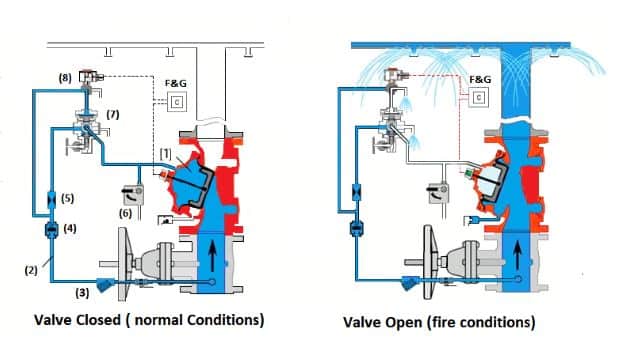A Deluge System is a fixed fire protection system consisting of nozzles connected with the pipes. The pipes, where the nozzles are located, are empty until the moment the deluge valve is opened to distribute the pressurized water and discharge it from the open nozzles.
Deluge valve systems are more complex as shown in the second figure, than wet and dry pipe systems because they consist of a greater number of attached components and equipment.
Upon activation of a fire detection system installed in the same area as the nozzles, the deluge valve is opened.
The different types of detection systems we can use are the following.
• Smoke
• Heat
• Ultraviolet (UV)
• Infrared (IR) detectors
The deluge system activation methods are as follows.
- pneumatic,
- Hydraulic,
- Electric,
- Manual trigger system
Or any combination of these, although in all cases, the deluge valve is hydraulically activated.
When the detection device activates by abnormal conditions, the deluge valve opens and water flows through the plumbing system out of all spray nozzles or sprinklers simultaneously.
Why Deluge valve is used?
Deluge systems are useful under emergency conditions when the rapid application of large amounts of water is a must due to environmental conditions or special hazards. These systems create a safety zone in high-risk areas or in areas where fire can spread rapidly spread. They can also be used to cool surfaces and prevent deformation or collapse of structures or prevent the explosion of tanks, processing lines, or transformers.
Other examples include storage or processing areas containing substances with a low flash point, warehouses containing combustible solutions, equipment pits, or product handling systems. When designing a flood system it is important to gather specific information about the hazard from the process.
The deluge systems consisting of foam water are also available in the market. They use foam-water nozzles, and a foam concentration into the water flow at a controlled rate. These foam-water systems are used to extinguish fires. For example extraction plants, fuel storage tanks, aircraft hangars, heliports. Also, areas where fires can occur due to spills of flammable liquids.
Deluge Valve Operation:
A typical Deluge valve system is shown below.

The Deluge valve is kept closed by the pressure of the water in the control chamber [1]. The valve gets opened, upon release of pressure from the control chamber.
Under the NORMAL operative state, water pressure is supplied to the control chamber through the priming line [2], filter [3], and a restriction orifice [5]. Water is trapped in the control chamber by a valve. Check valve [4], a manual emergency valve [6], and a relay valve [7] that is held in the supply position by a three-way solenoid valve [8].
The control chamber holds the diaphragm against the valve seat by the trapped water pressure. It seals tightly and keeps the tubing and nozzles dry.
What is Dry pipe, and wet pipe systems?
Dry Piping System
Dry pipe systems are almost the same as wet pipe systems with one important difference. In the dry pipe system, the pipe is not constantly full of water. But, the water is kept behind a valve in the dry pipe.
It is usually some distance from where the sprinklers are located. Like a wet pipe system, the fusible link or glass bulb in the sprinkler breaks when the temperature on the ceiling rises high. The heat-sensitive element (for example, a glass bulb) breaks when an automatic sprinkler is exposed for enough time to a temperature more than the nominal temperature.
However, in this case, the water is not immediately available because the pipe is not filled with water. Instead, the air is released from the now open sprinkler head. This creates a pressure drop that causes the valve on the dry pipe to open and water fills the system. And as a result, water will flow from the open sprinkler head.
Dry pipe systems are limited in size to avoid a delay between sprinkler operation and water flow. The size limitation is considered to minimize the amount of time as the water supply is delayed.
Wet piping systems
Wet pipe sprinkler systems are the most common. Water under pressure is filled in pipelines and installed only in frost-resistant areas of buildings. Wet piping systems are also very reliable and simple.
When an automatic sprinkler is exposed to heat for a sufficient time, greater than the nominal temperature, the heat-sensitive element (for example, a glass bulb) breaks, allowing water (held under pressure) to flow from the sprayer.
Construction Materials:
Ductile iron, cast steel, stainless steel, Ni-Al-Bronze, and Titanium.
Advantages of Deluge Valve:
- Less expensive.
- Use water for fire extinguishing.
- The Deluge system provides a faster response to fire by delivering water through all its open heads immediately also at the same time, which covers a large area.
- A deluge system is a dry system which means it is not at risk of having frozen pipes. The pipes of conventional sprinklers can freeze when exposed to cold temperatures because they are filled with water.
Disadvantages:
Possibility of damage to sensitive electronic systems.
Applications of Deluge Valve:
They are installed in practically all types of complexes and high hazard areas, such as offshore platforms, pipelines, multiple pipelines, fuel storage terminals, refineries, petrochemical complexes, and gas processing centers.
Read Next: